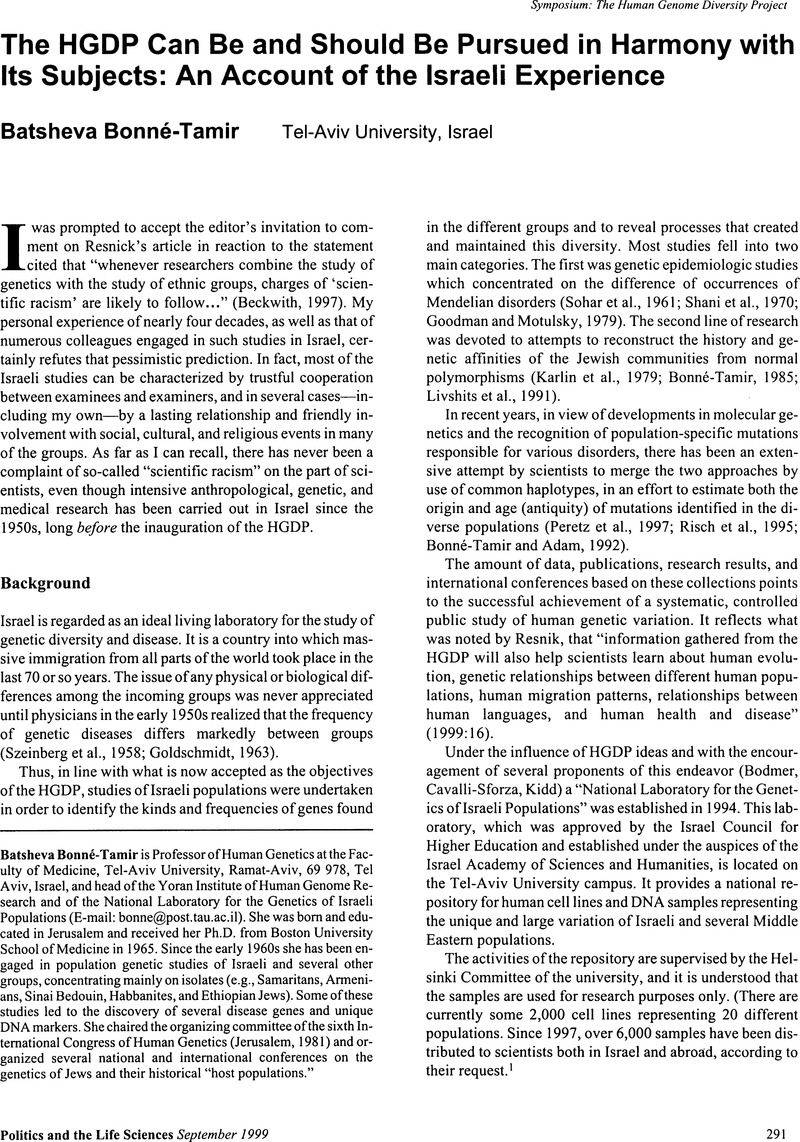No CrossRef data available.
Article contents
The HGDP Can Be and Should Be Pursued in Harmony with Its Subjects: An Account of the Israeli Experience
Published online by Cambridge University Press: 17 May 2016
Abstract
An abstract is not available for this content so a preview has been provided. Please use the Get access link above for information on how to access this content.

- Type
- Symposium: The Human Genome Diversity Project
- Information
- Copyright
- Copyright © Association for Politics and the Life Sciences
References
Beckwith, J. (1997). “The Responsibility of Scientists in the Genetics and Race Controversies” In Smith, E. and Sapp, W. (eds.), Plain Talk about the Human Genome Project. Tuskegee, AL: Tuskegee University.Google Scholar
Bonné, B. et al. (1970). “The Habbanite Isolate. I. Genetic Markers in the Blood.” Human Heredity 20: 609–22.Google Scholar
Bonné-Tamir, B. (1980). “The Samaritans: A Living Ancient Isolate.” In Eriksson, A.W. et al. (eds.), Population Structure and Genetic Disorders. London: Academic Press.Google Scholar
Bonné-Tamir, B. (1985). “riental Jewish Communities and Their Relationship with South West Asian Populations.” Indian Anthropology 1: 153–70.Google Scholar
Bonné-Tamir, B. and Adam, A., eds. (1992). Genetic Diversity Among Jews. Diseases and Markers at the DNA Level. Oxford University Press.Google Scholar
Goldschmidt, E., ed. (1963). The Genetics of Migrant and Isolate Populations. New York: Williams and Wilkins.Google Scholar
Goodman, R.M. and Motulsky, A. G., eds. (1979). Genetic Diseases among Ashkenazi Jews. New York: Raven Press.Google Scholar
Karlin, S. et al. (1979). “Analysis of Genetic Data on Jewish Populations. II. Results and Interpretations of Heterogeneity Indices and Distance Measures with Respect to Standards.” American Journal of Human Genetics 31: 341–65.Google ScholarPubMed
Livshits, G. et al. (1991). “Genetic Affinities of Jewish Populations.” American Journal of Human Genetics 49: 131–46.Google Scholar
Peretz, H. et al. (1997). “The Two Common Mutations Causing Factor XI Deficiency in Jews Stem from Distinct Founders: One of Ancient Middle Eastern Origin and Another of More Recent European Origin.” Blood 7: 2654–59.Google Scholar
Resnik, D.B. (1999). “The Human Genome Diversity Project: Ethical Problems and Solutions.” Politics and the Life Sciences 18: 15–23.Google Scholar
Risch, N. et al. (1995). “Genetic Analysis of Idiopathic Torsion Dystonia in Ashkenazi Jews and Their Recent Descent from a Small Founder Population.” Nature Genetics 9(2): 152–59.CrossRefGoogle ScholarPubMed
Shani, et al. (1970). “Dubin Johnson Syndrome in Israel. I. Clinical, Laboratory and Genetic Aspects of 101 Cases.” Quarterly Journal of Medicine 39: 549–67.Google Scholar
Sohar, E. et al. (1961). “Genetics of Familial Mediterranean Fever (FMF).” Archives Internal Medicine 107: 529–38.Google Scholar
Szeinberg, A. et al. (1958). “Selective Occurrence of Glutathione Stability in Red Blood Corpuscles of the Various Jewish Tribes.” Blood 13: 1043–53.Google Scholar




